Book contents
- Frontmatter
- Contents
- List of contributors
- Preface
- 0 Introduction
- Part one Bayesian frameworks
- Commentaries
- Part two Implications and applications
- 6 Implications of a Bayesian formulation of visual information for processing for psychophysics
- 7 Shape from texture: Ideal observers and human psychophysics
- 8 A computational theory for binocular stereopsis
- 9 The generic viewpoint assumption in a Bayesian framework
- 10 Experiencing and perceiving visual surfaces
- 11 The perception of shading and reflectance
- 12 Banishing the homunculus
- Commentaries
- Author index
- Subject index
10 - Experiencing and perceiving visual surfaces
Published online by Cambridge University Press: 05 March 2012
- Frontmatter
- Contents
- List of contributors
- Preface
- 0 Introduction
- Part one Bayesian frameworks
- Commentaries
- Part two Implications and applications
- 6 Implications of a Bayesian formulation of visual information for processing for psychophysics
- 7 Shape from texture: Ideal observers and human psychophysics
- 8 A computational theory for binocular stereopsis
- 9 The generic viewpoint assumption in a Bayesian framework
- 10 Experiencing and perceiving visual surfaces
- 11 The perception of shading and reflectance
- 12 Banishing the homunculus
- Commentaries
- Author index
- Subject index
Summary
Introduction
When we see objects in the world, what we actually “see” is much more than the retinal image. Our perception is three-dimensional. Moreover, it reflects constant properties of the objects and the environment, regardless of changes in the retinal image with varying viewing condition. How does the visual system make this possible?
Two different approaches have been evident in the study of visual perception. One approach, most successful in recent times, is based on the idea that perception emerges automatically by some combination of neuronal receptive fields. In the study of depth perception, this general line of thinking has been supported by psychophysical and physiological evidence. The “purely cyclopean” perception in the Julesz' random dot stereogram (Julesz, 1960) shows that depth can emerge without the mediation of any higher order form recognition. This suggested that relatively local disparity-specific processes could account for the perception of a floating figure in an otherwise camouflaged display. Corresponding electrophysiological experiments using single cell recordings demonstrated that the depth of such stimuli could be coded by neurons in the visual cortex, receiving input from the two eyes (Barlow et al., 1967; Poggio & Fischer, 1977). In contrast to this more modern approach, there exists an older tradition which asserts that perception is inferential, that it can cleverly determine the nature of the world with limited image data. Starting with Helmholtz's unconscious inference (Helmholtz, 1910) and with more recent formulations such as Gregory's “perceptual hypotheses”, this approach stresses the importance of problem solving in the process of seeing (Hochberg, 1981; Gregory, 1970; Rock, 1983).
- Type
- Chapter
- Information
- Perception as Bayesian Inference , pp. 391 - 408Publisher: Cambridge University PressPrint publication year: 1996
- 3
- Cited by



